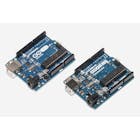Arduino Time Adjustable Relay Project © GPL3+
DESCRIPTION
Arduino Time Adjustable Relay Project
In this project, we enter the minutes and seconds data with the buttons. We press the run button and the relay changes position.The device connected to the output of the relay is working. The minutes and seconds count down values. When it is zero, the device at the output of the relay stops.You can add new features to the project.
We see the seven-segment display on many devices our daily life. They are generally operated by scanning method.Let's examine the schematic drawings.
Two types of seven-segment display screens are produced.These screens are known as cathode common and anode common. The appropriate screen is used according to the needs of the project. In our project, anode common display screen is used.
We need one relay in the project. We see the module that I designed with 5V coil voltage.
Data entry is one of the most important issues in embedded electronic systems. In our project minute and second data are entered with the help of buttons.
I design developer tools with Altium Designer software.You can buy design files. You can use it in new projects.Altium Designer Projects
https://www.altiumdesignerprojects.com
Project Schematichttps://www.altiumdesignerprojects.com/product/seven-segment-led-display-4x
https://www.altiumdesignerprojects.com/product/led-button-board
https://www.altiumdesignerprojects.com/product/relay-5v
Thanks.
You can follow me.I will share my projects with you.
Arduino Time Adjustable Relay Project
In this project, we enter the minutes and seconds data with the buttons. We press the run button and the relay changes position.The device connected to the output of the relay is working. The minutes and seconds count down values. When it is zero, the device at the output of the relay stops.You can add new features to the project.
We see the seven-segment display on many devices our daily life. They are generally operated by scanning method.Let's examine the schematic drawings.
Two types of seven-segment display screens are produced.These screens are known as cathode common and anode common. The appropriate screen is used according to the needs of the project. In our project, anode common display screen is used.
We need one relay in the project. We see the module that I designed with 5V coil voltage.
Data entry is one of the most important issues in embedded electronic systems. In our project minute and second data are entered with the help of buttons.
I design developer tools with Altium Designer software.You can buy design files. You can use it in new projects.Altium Designer Projects
https://www.altiumdesignerprojects.com
Project Schematichttps://www.altiumdesignerprojects.com/product/seven-segment-led-display-4x
https://www.altiumdesignerprojects.com/product/led-button-board
https://www.altiumdesignerprojects.com/product/relay-5v
Thanks.
You can follow me.I will share my projects with you.







